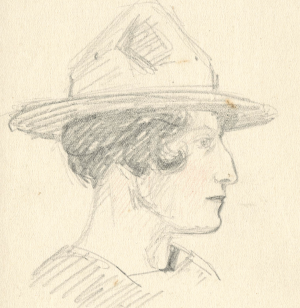Suzanne Creston ( - )

Born in Paris in 1899 into a family originally from Berry, Suzanne Candré-Creston had no Breton ancestry, but was no less committed to promoting decorative arts that were Breton, modern and popular. Alongside her husband René-Yves Creston, whom she married in 1921, she helped found the Seiz-Breur artistic fraternity in autumn 1923. The young woman devoted herself fervently to designing a motif of printed fabric and Henriot earthenware, for the space occupied by the group at the Exposition des arts décoratifs et industriels modernes in Paris in 1925. For over ten years, she took part in the destiny of the Seiz Breur, mainly through essays and sketches.
But the young artist also forged her own path, which placed her at the forefront of the renovation of the applied arts. She made a radical break with the surplus of decoration with which regionalism was artistically identified, turning away from the clichés of the "little Breton" sculpted in bragoù arms and hat, but also from ermine and triskeles. On the contrary, she constantly emphasizes combinations of shapes and colors, which she arranges into rhythmic geometries. In her earthenware "services de table populaires", she favors the repetition of dynamic lines in black and ultramarine blue, sometimes in blue and yellow (an allusion to the Breton colors of the sea and gorse flowers).
The same culture of the art of her time is evident in her designs for Breton-language theater, which she studied in 1927 for the Cercle Celtique in Paris.
As part of a workshop run by the Seiz Breur called Nadoziou (the needles), she experimented with embroidered festoon motifs for table linen and figures (interlaced initials), for which she fused solid shapes that she intended for blouses, book covers and handbags. She also worked to renew the ornamentation of costumes in Quimper, Quimperlé, Elliant and Ergué-Gabéric, and pleaded tirelessly, but unsuccessfully, for the publication of a page or journal of Breton fashions.
Following her divorce in 1945, she put her projects on hold. Faced with the incomprehension of manufacturers who, apart from Henriot, generally scorned her, she retired to her sister's in Ménétréol-sous-Sancerre, stopped creating and died in 1979.
